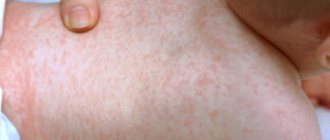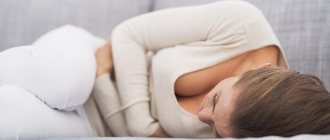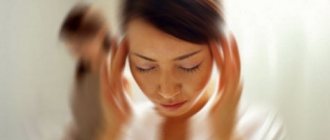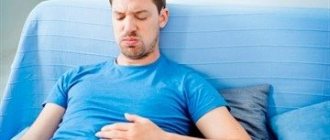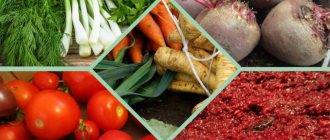Drug treatment for green stools
Diarrhea is a disorder of the gastrointestinal tract, which can occur for various reasons in both adults and children.
For children in the first years of life, this condition is very dangerous and is fraught with the rapid development of dehydration. Fecal masses with diarrhea may have different pathological colors and contain impurities that should normally be absent there.
The sudden appearance of loose green stools should especially alert a person, since in most cases this is a characteristic symptom of intestinal infection, dysbacteriosis and other diseases.
However, there are situations when green diarrhea does not pose a threat to human health and begins as a result of taking medications or certain foods. Finding out the cause of such changes in the color and consistency of stool, as well as prescribing treatment, is solely the task of the doctor, especially when it comes to a child.
The reasons why a person develops green diarrhea can be due to various factors. These include:
- intestinal infections;
- imbalance of intestinal microflora;
- diseases of the gastrointestinal tract;
- taking certain medications;
- consumption of certain products.
Determination of the cause that caused green diarrhea is carried out taking into account the general condition of the patient, the presence of accompanying symptoms, test results and, if necessary, special instrumental examinations.
Intestinal infections are one of the most common causes of green diarrhea in adults and children. Infection occurs when pathogens enter through the mouth as a result of human consumption of contaminated food and water or through dirty hands. Frequent, loose, green stools are not the only symptom of intestinal infections; in addition to this, a person experiences:
- high body temperature;
- vomit;
- nausea;
- sharp abdominal pain;
- weakness, dizziness;
- lack of appetite.
The causative agents of intestinal infectious diseases can be viruses, bacteria, parasites and fungi
Once in the digestive tract, pathogens of intestinal infections can cause inflammatory processes throughout its entire length or only in certain areas (gastritis, duodenitis, enteritis, colitis).
The most common viral intestinal infections include rotavirus and enterovirus.
Among bacterial infectious diseases of the gastrointestinal tract, the most common are salmonellosis, dysentery, and escherichiosis.
Important: During intestinal infections, the excreted stool contains a large number of leukocytes, which is the reason for the green color of the stool. Also, mucus and blood are found in the stool.
The most dangerous cause of green stool is internal bleeding in the stomach or intestines. As a rule, the feces acquire a black color, corresponding to the products of complete oxidation of the iron contained in the blood. However, in some cases, oxidation does not complete, which causes dark green diarrhea.
Green stools with a liquid consistency are the result of some problems in the functioning of the gastrointestinal tract or blood diseases. For example, if a person has increased breakdown of red blood cells, the liver produces large amounts of bilirubin, which subsequently enters the intestines and turns the stool green.
Another reason for green stool may be a malfunction or insufficient amount of enzymes secreted by the pancreas and involved in the digestion of food.
An imbalance of microflora in the intestines often causes green diarrhea in a child. In adults, dysbiosis is much less common than in children. The following factors can cause it:
- poor nutrition;
- allergic reactions;
- previous intestinal infections;
- taking antibiotics;
- decreased immunity.
An imbalance of intestinal microflora is that, under the influence of certain reasons, there is an increased growth of pathogenic and opportunistic bacteria. This leads to a change in the ratio between beneficial and pathogenic microorganisms and disrupts the normal functioning of the intestines.
Dysbacteriosis is accompanied by increased gas formation in the intestines, abdominal pain and nausea
Green diarrhea with traces of mucus often occurs in a child in the first months of life. A newborn's intestines are not yet populated with the bacteria they need.
The route of delivery, type of feeding and living conditions in the first days of life play a major role in the formation of microflora in a baby.
In children born naturally, receiving exclusively mother's milk and staying close to their mother all the time after birth, the risk of developing dysbiosis is minimal. In other cases, disruption of the formation of intestinal microflora occurs in many children.
Important: In young children, accompanying symptoms of dysbiosis, in addition to diarrhea, are bloating, colic and allergic skin rashes.
Liquid green stool occurs in many people who have been treated with antibacterial drugs.
This is due to the fact that antibiotics change the normal composition of the intestinal microflora, and as a result, dysbiosis develops.
To prevent such complications after treatment with these drugs, it is recommended to take probiotics simultaneously with them, which help maintain beneficial microflora in the intestines.
In rare cases, green coloration of stool is caused by taking medications containing bismuth and iron compounds.
Nutritional Features
Green diarrhea in an adult and a child may not pose any health hazard and can be caused by excessive consumption of sweet carbonated water containing artificial green dyes, raw greens or vegetables.
Liquid stool consistency is absolutely normal for children until complementary foods are introduced. The green tint of stool should also not be regarded as a cause for particular concern for breastfed and bottle-fed babies, if the child feels well, gains weight and his appetite remains unchanged.
At the stage of introducing complementary foods to children, when consuming certain foods (peas, green beans, zucchini, broccoli, etc.) and fruit juices, feces may turn green and have a liquid consistency.
Green diarrhea in a 1-year-old child who is bottle-fed can be caused by the presence of iron compounds in the formula
Important: Green stool in a breastfed baby sometimes occurs in response to the mother’s violation of the diet recommended for women during lactation.
With any type of diarrhea, it is important to prevent dehydration, especially if diarrhea began in a child. In this case, it is necessary to take measures after the first loose stool.
Prevention of dehydration consists of increasing the amount of fluid consumed and taking special rehydrating solutions (Regidron, Gastrolit, Gidrovit, etc.).
They will help replenish the body's loss of water and electrolytes.
To prescribe treatment for green diarrhea in a child or adult, you need to determine its cause. The diagnosis is made through examination and questioning of the patient by a doctor, as well as based on the results of:
- general stool analysis;
- general blood test;
- bacteriological analysis of feces;
- Ultrasound of the abdominal organs, etc.
If you have severe diarrhea, it is not recommended to take any medications on your own before visiting a doctor, as this may complicate the diagnosis.
Regidron and its analogues are considered first aid for patients with diarrhea.
If the cause of green diarrhea is an intestinal infection, then treatment should be carried out in a hospital setting.
Depending on the type of pathogen that caused the disease, antibiotics or antiviral drugs, sorbents, and agents to enhance immunity are necessarily prescribed. If dysbiosis is detected, treatment is carried out using probiotics and prebiotics.
As part of complex therapy for green diarrhea, a diet is also prescribed. It is aimed at normalizing carbohydrate, fat and protein metabolism, as well as restoring inflamed mucous membranes of the affected parts of the gastrointestinal tract.
It is prohibited to consume spicy, fried and fatty foods, alcoholic and carbonated drinks, smoked foods, legumes and vegetables that promote gas formation in the intestines. The following products are recommended:
- rice and buckwheat porridge with water;
- boiled or steamed meat;
- vegetable broths;
- stale white bread or crackers;
- boiled or baked vegetables.
Important: Green diarrhea in an infant, accompanied by vomiting and high fever, is an indication to urgently call a doctor!
Green diarrhea in an adult or child is a common occurrence, but it is not always of a harmless nature.
Not in every case it is possible to stop unusual diarrhea with home remedies, especially if loose stools are accompanied by other symptoms.
Frequent diarrhea inevitably leads to dehydration, loss of salts and microelements, which is especially dangerous for weakened people, pregnant women and young patients. The following article will tell you what to do if green diarrhea appears.
In order to find out for sure why the digestive system malfunctioned, an in-person consultation with a doctor is necessary. However, there are a number of signs by which you can determine how dangerous a change in the color and consistency of stool is.
The appearance of greenish stool most often has an infectious nature. Infection with salmonella, shigella or rotavirus is signaled by a number of other unpleasant symptoms: acute pain in the epigastric region, fever, chills, nausea and vomiting.
If an intestinal infection occurs, the stool often becomes yellow-green in color and there is foam or mucus in the stool.
If signs of poisoning appear, it is recommended to seek medical help without attempting treatment on your own, especially if the situation concerns a child or a pregnant woman.
Possible reasons
Unexpected green diarrhea should be cause for concern and may be a sign of infection or dysbiosis. Sometimes green loose stools are harmless and occur after taking certain medications or foods.
Only experienced specialists can determine the cause of the specific color of stool and prescribe the correct treatment.
Liquid green stool without inclusions in an adult appears:
- Presence of dyes in food.
- When treated with antibiotics. These drugs kill white blood cells, causing stool to take on a characteristic color.
- After eating vegetables in excessive quantities.
- For bleeding in the gastrointestinal tract.
- With liver damage.
The causes of watery stool can be divided into infectious and non-infectious.
Infectious nature
Most often, the green color of stool is a sign of infections in the body. Bacteria that enter through the oral cavity disrupt the normal functioning of internal organs. Under the influence of microorganisms, fermentation processes begin in the stomach, provoking the appearance of putrefactive discharge. The stool changes from its usual brown color to a light greenish tint. Symptoms of the disease:
- weakness;
- increased body temperature;
- dehydration (if the disease does not subside for a long time).
Non-infectious
Non-infectious causes of green diarrhea in adults include:
- Nutritional - a consequence of food allergies or unbalanced nutrition. The appearance of yellow-green diarrhea may be associated with dyes contained in food (fast food or sweets), or with individual intolerance to green tea.
- Toxic - mercury or arsenic (poisoning with these substances), uremia.
- Medicinal - green diarrhea in an adult appears as a reaction to long-term treatment with antibacterial drugs. This therapy reduces the number of “good” bacteria in the intestines and disrupts its microflora. Taking medications should be postponed and consult a doctor to change the treatment algorithm. To prevent the negative effects of antibiotics, you need to take probiotics.
- Neurogenic – when the nervous regulation of intestinal motility is disrupted.
- Internal bleeding can cause green diarrhea with mucus.
- Diseases of internal organs. Frequent episodes of watery, dark green diarrhea (sometimes with foam) are a consequence of diseases of the internal organs, the existence of which the patient is not aware of.
Causes of green diarrhea in adults
Diarrhea is a painful and uncomfortable condition characterized by the following symptoms:
- frequent bowel movements;
- loose stools;
- attacks of abdominal pain;
- flatulence, accumulation of gases in the intestines.
In addition, this condition may be accompanied by fever, as well as other symptoms, such as:
- fast fatiguability:
- general malaise, weakness;
- pale skin;
- nausea, vomiting.
With such manifestations of the disease, compliance with the rules of dietary nutrition and rest may not be enough to eliminate them. In such cases, it is recommended to consult a doctor to exclude the development of complications.
If during examination no infection is detected in the patient, medications containing enzymes are prescribed for treatment, and the principles of proper nutrition and diet are determined. Products that put additional stress on the digestive organs and irritate their mucous membrane are excluded from the diet.
Medications for the treatment of green diarrhea in adults:
- Antibiotics, the course of treatment is from 5 to 7 days: Metronidazole, Amoxicillin, Tetracycline. Drugs are prescribed taking into account the patient’s individual intolerance.
- Enzymes that promote the breakdown of food: Mezim, Pancreatin, Creon.
- Sorbents that absorb toxins and harmful decomposition products: Enterosgel, Polysorb, activated carbon, Atoxil.
- Medicines that stop diarrhea: Smecta, Loperamide, Intectrix.
- Probiotics to restore a healthy environment: Linex, Narine, Normoflorin.
When an adult vomits, there is a loss of fluid; to replenish its supply, enrich the body with useful substances and normalize the salt balance, it is recommended to take the drug Regidron 2 tablespoons every 2 hours.
The prescription of medications is carried out by a specialist, taking into account the interaction of the drugs with each other.
In complex cases and associated complications, the patient is recommended to receive inpatient treatment. In case of severe poisoning, gastric lavage and intravenous administration of drugs for acute dehydration are prescribed. Depending on the nature of the disease, medications are prescribed to relieve inflammation, lower temperature, and relieve pain.
- Medication
- Dyspeptic
- Infectious
- Nutritional
- Toxic
- Neurogenic
Now let's talk about each one separately.
Medication
In this case, the cause of greenish loose stool in an adult is a consequence of taking medications. Mainly, when it comes to medications that cause green diarrhea in an adult, antibacterial drugs (antibiotics) are first mentioned, and this is not without reason.
Antibiotics successfully cope with pathogenic bacteria, but at the same time they also successfully suppress all beneficial microflora in the intestines. The condition we end up with is called dysbiosis. With the development of modern medicine, it can easily be avoided by taking special pro- and prebiotics simultaneously with antibacterial drugs or immediately after a course of treatment, which will accelerate the natural process of colonizing the intestines with beneficial bacteria.
Also, green feces in an adult (not always diarrhea) occur after taking iron-containing drugs and activated carbon.
Alcohol has approximately the same effect on the intestines as antibiotics. Alcohol-containing products also destroy all bacteria in the body, and that is why cases of gray-green diarrhea in an adult after prolonged libations are so common.
Dyspeptic
Here, diarrhea occurs due to chronic diseases and disorders of the gastrointestinal tract. These are gastritis, duodenitis, peptic ulcers, tumors. This diarrhea is usually chronic. It is here that internal bleeding is common, due to which diarrhea in an adult becomes dark green or black, with elements of blood.
Infectious
Why does greenish diarrhea occur in an adult for this reason? The body is attacked by viruses, bacteria or some kind of infection.
Viral pathogens include rota virus and enterovirus, infections include dysentery, and bacteria include salmonella or E. coli. We have mentioned only the most common pathogens; in fact, there are many more. Infections (let’s combine everything in one word so as not to get confused) can enter our body either through airborne droplets, through unwashed hands, or orally, if we eat a product (meat, for example, or eggs) that has not been sufficiently heat-treated.
The symptoms of intestinal infections in an adult are approximately the same - diarrhea with green water begins, a high temperature rises, nausea and vomiting may occur. Weakness, dizziness, and loss of strength are also typical. Such diseases are very dangerous; their treatment must be carried out under the supervision of a doctor, and some - only in a hospital.
Nutritional
Alimentary diarrhea is diarrhea that occurs either against the background of a food allergy, or due to banal overeating or violation of nutritional rules. In the event of an allergic reaction, in addition to loose stools, hives and red rashes on the face and body cannot be avoided. Allergic conjunctivitis and Quincke's edema are also possible.
But this is what the concept of “violation of nutritional rules” means: the above-mentioned overeating, a large amount of coarse and fatty foods, swallowing unchewed pieces, cold water immediately after eating. In such a situation, an adult will experience green diarrhea with mucus and remnants of undigested food.
Toxic
Simply - poisoning. You can be poisoned by low-quality food, or you can be poisoned by toxic substances, for example, mercury vapor. Almost everyone has experienced food poisoning to varying degrees of severity, and its symptoms are familiar to adults: nausea, vomiting, green loose stools and fever.
Neurogenic
Sudden acute diarrhea that occurs due to stress is also called “bear sickness.” Due to the experiences suffered, a certain malfunction occurs in the functioning of the nervous system - and, as a result, the person finds himself chained to the toilet. For treatment of such digestive disorders, in addition to fixative drugs, sedatives are also used.
Find out the recipe for rice water for diarrhea on our website.
In addition to the above, there are several other reasons why a person may develop diarrhea of uncharacteristic color. However, they are quite harmless. Yellow-green diarrhea in an adult can begin due to excessive consumption of vegetables and fruits of this shade, as well as due to an addiction to sweet green carbonated drinks.
Stool liquefaction and its greenish color are characteristic for women during menstruation. It's all about an excess of the hormone progesterone in the female body these days.
Of course, treatment for green diarrhea in an adult will depend on what disease it is a symptom of. For dysbacteriosis, pre- and probiotics will be prescribed (Linex, Hilak-Forte, Bifidum-Bakterin), for infections - antibiotics or antiviral drugs, for poisoning - sorbents and gastric lavage, for allergies - antihistamines, for neurogenic diarrhea - sedatives.
- Feel free to take sorbents. You should never take any other medications without a doctor’s instructions, but medications that will help cleanse the body of toxins are safe and will not aggravate the disease. Sorbent preparations: activated carbon, Enterosgel, Polyphepan, Polysorb, Smecta, Neosmectin.
- Loose stools are dangerous due to dehydration. Therefore, be sure to drink water-salt solutions, such as Ringer's solution, Regidron, etc. they will help maintain the correct fluid balance in the body.
Other causes of loose green stools cannot be ruled out:
- pancreas pathology;
- intestinal tumor;
- hereditary and acquired fermentopathy;
- infectious intestinal diseases;
- adenocarcinoma;
- liver and gallbladder diseases;
- poisoning with nitrates or household chemicals.
The main cause of green diarrhea in women during pregnancy is related to diet. During this period, expectant mothers eat a lot of leafy vegetables. Spinach, broccoli, and dill contain chlorophyll, which can cause green stool.
In the first trimester, frequent diarrhea can lead to miscarriage. In later stages, food poisoning with nausea and vomiting is dangerous due to dehydration.
Medicines
Taking antibiotics for a long time leads to the development of dysbiosis. Antibacterial drugs destroy not only pathogenic, but also beneficial intestinal microflora. As a result, food is not digested, liquid green feces and flatulence appear.
Black-green diarrhea is associated with the use of activated carbon tablets, which is prescribed for poisoning. After stopping the medication, the color of the stool is restored.
Green feces appear in bottle-fed babies. Infants receive an adapted formula. It may contain increased amounts of iron, which colors the stool. Green stool in a breastfed baby can be caused by the mother's food.
Intestinal infection
Diarrhea with greens and a temperature of up to 38.0°C occurs due to intestinal infections. The most common causative agent of the disease is rotavirus. The bowel movements include mucus and blood. The disease is characterized by frequent green diarrhea of water, which quickly leads to dehydration.
- If diarrhea recurs frequently and is accompanied by loss of strength and fever, this indicates an intestinal infection. Doctors prescribe the intestinal antiseptic Enterofuril, the combined antimicrobial drug Dependal, sorbents, and the probiotic Lactobacterin.
- Diarrhea caused by taking medications requires discontinuation of the drug and restoration of the intestinal microflora with the help of Bifidumbacterin, Linex, Enterol and a special diet.
- In the case of green diarrhea associated with pancreatic dysfunction, the doctor prescribes enzymes: Pancreatin, Panzinorm forte.
- Diarrhea in an artificial baby is eliminated after changing the nutritional formula.
- gastrointestinal diseases of infectious origin;
- chronic gastric ulcers in the acute phase;
- bleeding inside the gastrointestinal tract;
- pathology of the pancreas;
- specific reaction of the body to taking new products;
- ingestion of low-quality products, which led to poisoning;
- side effects of medications.
Yellow diarrhea
- Causes
- Accompanying illnesses
- Treatment
- on this topic
Yellow diarrhea can occur both due to malnutrition and pathology of the digestive system.
With diarrhea, the weight of stool exceeds 250 grams per day (approximately more than 3 acts of defecation), and the amount of water in it is more than 60–85%. Severe diarrhea can lead to hypovolemia, hypo- and dehydration, changes in electrolyte balance and acid-base balance of the blood. If left untreated, the functioning of the heart, kidneys, brain and other organs is disrupted. Therefore, if diarrhea occurs periodically, it is necessary to undergo a medical examination to determine and eliminate the cause.
Causes
Depending on the mechanism of development, diarrhea is divided into:
- to osmotic (in the intestinal lumen the content of electrolytes increases and water rushes along the concentration gradient). Develops after taking laxatives or antacids containing magnesium, consuming xylitol, sorbitol, mannitol, certain medications, as well as enzyme deficiency. Stool normalizes after two to three days of fasting;
- secretory (the secretory function of intestinal epithelial cells increases significantly). Non-infectious develops due to the use of laxatives or certain medications, intoxication, and also as a result of the production of secretion stimulants by a hormone-producing tumor. Infectious secretory diarrhea develops when the mucous membrane is exposed to infectious agents (Vibrio cholera, E. Coli, Helicobacter jejuni, Yersinia enterocolitica, Clostridium difficile, Staphylococcus aureus);
- exudative (as a result of damage to the intestinal epithelium, water, electrolytes, proteins, as well as erythrocytes and leukocytes leak into the lumen from the blood and lymphatic vessels). Develops due to exposure to pathogenic bacteria (Shigella, Salmonella, Yersinia, Escherichia, Aeromonas), viruses and protozoa. Non-infectious diarrhea occurs with nonspecific ulcerative colitis. With this mechanism, blood is noticeable in the stool;
- diarrhea that occurs against the background of impaired intestinal motility (develops due to a weakening or strengthening of intestinal motor activity, which leads to accelerated passage of intestinal contents).
The color of stool depends on the food prevailing in the diet. If a person eats a lot of meat, the feces become black-brown; plant foods give a light brown tint.
A dairy diet results in light yellow stool. With increased fermentation of carbohydrates, feces have a greenish-yellow color.
Based on the color of the stool, its consistency and the presence of foreign impurities, one can make an assumption about the cause of the symptom.
So, if the inflammatory process is more pronounced in the small intestine, then the discharge is abundant and watery, may be foamy and interspersed with undigested food particles.
If the large intestine suffers more, then there is a frequent urge to defecate (sometimes false), and the stool is not abundant, but with mucus.
If the functions of the pancreas are impaired, the stool is fatty (steatorrhea), and if the liver is damaged, the stool is white.
Yellow diarrhea in an adult appears due to a lack of bile enzyme or as a result of accelerated passage of feces
Accompanying illnesses
With diseases of the digestive tract, the processes of fermentation and decay intensify in the intestines, therefore the color and smell of feces change. A sour smell appears if there is increased fermentation in the intestines. With pathology of the digestive system, regardless of the food consumed, the stool changes color and can become green, yellow, bright yellow or black.
Activated charcoal for diarrhea in adults
Green diarrhea indicates the development of an intestinal infection (dysentery, salmonellosis, dysbacteriosis), liver dysfunction and blood diseases.
Black stool appears due to bleeding in the upper digestive tract, and may also be a result of taking medications containing iron, bismuth, activated charcoal, and multivitamins (the condition does not worsen).
And if black or green feces with diarrhea can scare, then yellow feces are often considered sick variants of the norm and they are in no hurry to see a doctor. In most cases, yellow stool in adults appears due to serious illnesses that require medical intervention. Yellow color of stool during diarrhea occurs under the following conditions.
For infectious enteritis (escherichiosis)
The disease manifests itself as nausea, vomiting, pain and gurgling in the abdomen, diarrhea, headache, and fever. Stools up to 10–15 times a day, watery, profuse. With prolonged diarrhea, dehydration develops.
Salmonellosis
When the disease occurs, the body temperature rises, symptoms of intoxication appear, the patient is bothered by spasmodic pain in the upper abdomen or umbilical region, nausea, vomiting, and diarrhea.
The stool is watery, foamy, foul-smelling, dark yellow in color, sometimes with a greenish tint.
If the bacterium is also in the large intestine, then by day 2–3 of illness the volume of bowel movements decreases, and blood and mucus are noticeable in the stool.
Rotavirus infection or intestinal flu
It is considered a disease of dirty hands because the infection enters the body through unwashed hands or food.
When the disease occurs, body temperature rises, vomiting, nausea, abdominal pain, flatulence, and rumbling appear.
The stool is copious, watery-foamy, often yellow-green or bright yellow, and then becomes gray-yellow, with a pungent odor, usually without noticeable impurities, but sometimes with mucus.
In case of infectious diseases, defecation can be up to 20 times a day, diarrhea persists from 3 to 7 days
Dysentery
Acute infection causes an increase in temperature to febrile levels, symptoms of poisoning, cutting pain in the right iliac region or lower abdomen, sometimes nausea and vomiting. Diarrhea can occur up to 10 times a day, the discharge quickly becomes scanty, blood, pus, and mucus are noticeable in it. The urge to defecate is very painful, sometimes false.
Ulcerative colitis
The stool becomes light yellow and may contain pus and blood. Abdominal pain is severe, cramping, and its localization depends on the location of the intestinal lesion (lower abdomen, left iliac region).
Pancreatic diseases
With pathology, the stool is mushy, yellowish in color with a greasy sheen, since it contains a large amount of undigested fats. With this pathology, patients suffer from belching, constant nausea, vomiting after eating, and girdle pain in the abdomen.
Liver pathologies
When the gland is inflamed, the stool takes on a shade from light yellow to gray, since bilirubin, which gives the stool a light brown color, does not disintegrate and is not excreted from the body, but continues to circulate through the bloodstream, causing itching, rashes, yellowing of the skin and sclera.
Changes in hormonal levels
Liquid yellowish feces in an adult may appear when hormone levels change (during pregnancy, menopause). It often appears in diabetes and thyroid diseases.
Long-term drug therapy
Antibiotics can cause changes in the consistency and color of stool. Medicines affect the composition of the intestinal microflora, which leads to dysbiosis. Most often, loose yellow stools appear due to an inflammatory process in the intestines, dysbiosis or pancreatitis (a violation of the liver and pancreas is indicated by a yellow coating on the tongue).
But the color of stool also depends on the foods consumed; for example, yellow diarrhea in an adult is observed if a person is on a strict dairy diet or eats only carbohydrate foods.
When a symptom appears, you need to pay attention to your general health and if it is satisfactory (no abdominal pain, nausea, vomiting), then you should change your diet and adhere to a rational diet.
No drug treatment is required if diarrhea occurs after overeating, stress or climate change
Important! If inclusions are visible in the stool (food particles, blood, mucus, pus), there are symptoms of intoxication, or yellow water comes out during bowel movements, then you should urgently seek medical help.
If diarrhea occurs, you should stop eating for at least 4 hours and drink as much water as possible to avoid dehydration. Next, you should follow diet No4, which reduces inflammation, reduces fermentation and putrefaction in the intestines. Products that stimulate secretion and peristalsis are excluded from the diet.
For diarrhea, you can eat crackers or dried wheat bread, porridge cooked in water, slimy soups, dietary meat and fish, boiled vegetables, jelly, and fermented milk products. Dishes should be steamed or boiled, and they should be eaten warm, since cold increases intestinal motility.
Eliminate diarrhea with sorbents. These drugs absorb toxic substances and remove them from the body. Medicines are produced in tablets, capsules, powders for the preparation of suspensions, gels and drinking solutions.
The following can be used as the main active ingredient:
- activated carbon (Sorbex, Karbolen);
- aluminosilicate (Smecta, Enterosgel, Neosmectin, Diosmentit);
- silicon salts (Polysorb, White Coal, Atoxyl);
- organominerals (Polifan, Polyphepan);
- plant components (Piktovit, Chitosan).
Sorbents differ in their sorption capacity and spectrum of action (which enterosorbents to give to a child with yellow diarrhea can be read here).
With the help of sorbents, only harmful compounds that negatively affect the intestinal mucosa can be removed.
If yellow diarrhea in an adult appears due to the development of an infection, then you will need to take antibacterial or antiviral drugs, which can only be prescribed by a doctor.
If diarrhea is caused by bacteria or protozoa, then it is necessary to take antibacterial agents
Antidiarrheal drugs cannot be taken in case of poisoning, since they stop intestinal motility, which prevents the elimination of toxic substances, which is why they continue to be absorbed by the mucous membrane and poison the body. If the symptom occurs due to increased intestinal motor function, then medications are used that reduce peristalsis, for example, Imodium.
Eliminating a periodically occurring symptom can only be done by finding out the cause of the pathology and understanding the mechanism of development of diarrhea. If the diarrhea is not infectious in nature, then it is necessary to conduct a full examination of the gastrointestinal tract to determine the underlying disease that caused the stool disorder. The patient must take a blood test, stool test, and undergo an ultrasound of the abdominal cavity.
A blood test can determine whether an inflammatory process is occurring in the body and how severe it is.
Stool analysis shows whether there is blood, mucus, undigested food particles, fat, starch in the stool, on the basis of which a preliminary diagnosis can be made.
An ultrasound examination will help determine the contours, structure and size of the abdominal organs, and will reveal whether there are any neoplasms.
For secretory diarrhea, oral rehydration is prescribed (soldering with drugs that restore water-salt balance), and if this is not possible, infusion therapy (dropper) is indicated.
To eliminate the hormone-producing tumor, surgery is performed, and if this is not possible, then octreotide is prescribed, which prevents the excessive formation of hormones that activate enterocytes.
To find out the cause of yellow diarrhea, you should consult a doctor. After conducting the examination, the specialist will make a diagnosis and prescribe the necessary treatment, which includes a therapeutic diet and, in some cases, medication (antibiotics, enterosorbents, antidiarrheals).
Source: https://vrbiz.ru/diagnostika/ponos-zheltogo-cveta
Diagnostics
To fix the problem, you need to find out the reasons for its occurrence. To determine the diagnosis, the specialist conducts an anamnesis of the deviations that have arisen, clarifies the signs and circumstances of the manifestation of symptoms.
In addition, the following examinations are prescribed:
- stool coprogram for diagnosing the digestive tract;
- clinical examinations of stool and urine;
- Ultrasound of the abdominal organs.
Based on the results of the examination, a diagnosis is established and treatment is prescribed.
You can diagnose which disease caused diarrhea using three components:
- Examination by a doctor, including palpation of internal organs
- Blood tests (general and biochemical) and stool (general, microflora, worm eggs, coprogram)
- Examination using medical equipment (ultrasound, x-ray, colonoscopy, irrigoscopy).
Prevention
In order not to encounter any of the diseases that provoke such diarrhea, you need to follow several very important rules:
- Always wash your hands: before eating, after visiting the restroom, after returning home from the street. Statistics show that the largest percentage of intestinal infections is due to unwashed hands.
- Wash fresh vegetables and fruits. At a minimum, with running water, although some experts recommend treating them with a baking soda solution
- All products on your table must undergo heat treatment
- And the water you drink should be either boiled or bottled mineral.
You can find out how to stop diarrhea using folk remedies on our website.
Green diarrhea in an adult or child is a common occurrence, but it is not always of a harmless nature. Not in every case it is possible to stop unusual diarrhea with home remedies, especially if loose stools are accompanied by other symptoms. Frequent diarrhea inevitably leads to dehydration, loss of salts and microelements, which is especially dangerous for weakened people, pregnant women and young patients. The following article will tell you what to do if green diarrhea appears.
First aid for green diarrhea
If an adult has loose, greenish stools, it is imperative to see a doctor. In case of uncontrollable vomiting, fever, severe abdominal pain, call an emergency team.
For mild food poisoning, you can get help at home:
- Rinse the stomach with a soda solution (per 1 liter of water - 1 tablespoon of sodium bicarbonate). Repeat the manipulation 2–3 times until the food is completely removed.
- Drink enterosorbent - Smecta, Enterosgel or 4 crushed tablets of activated carbon in the form of a suspension with water.
- Drink plenty of fluids to prevent dehydration from repeated vomiting and diarrhea. To do this, it is recommended to take Oralit or Regidron dissolved in warm water.
Before the doctors arrive, you should drink plain or mineral water without gas in small portions every half hour. After each episode of diarrhea, you should take 100 ml of Glucosolan or Regidron.
Causes of green diarrhea with different shades
Diarrhea can have different colors and contain mucus, blood, and foamy elements. Based on the nature of the discharge, its quantity and consistency, one can assume what pathology is bothering the patient.
Diarrhea with blood
Blood inclusions are observed in diseases of the gastrointestinal tract and blood of the creative system.
Sometimes such symptoms are characteristic of liver pathologies, when bilirubin is increased and the breakdown of red blood cells is increased.
Black-green
Black-green color of the stool may indicate poisoning by poisons, for example, mercury, arsenic. Associated symptoms include bloating, headache, discomfort in the abdominal area, and vomiting. With toxic diarrhea, the patient feels dry mouth with excessive salivation - cramps of the calf muscles.
Black stool may indicate hidden internal bleeding or taking iron-containing medications.
Dark green
Dark green stool is characteristic of dysbacteriosis. Microflora can be disrupted for many reasons. Most often, provoking factors include allergies, infections, decreased immunity, taking antibiotics, and poor nutrition.
When beneficial microflora dies and pathogenic microflora increases, the patient experiences flatulence, bloating, problems with stool, nausea, discomfort in the intestinal area, and diarrhea.
Yellow-green
Yellow discharge is typical for patients with infection. The temperature also rises, the person experiences weakness, aversion to food, experiences muscle pain, and is bothered by nausea and dehydration.
Yellow-green feces may indicate hepatitis, gastritis, ulcers, or pancreatitis.
Diarrhea with water
Watery stools are a sign of intestinal infection. The route of infection is often domestic through contaminated hands, water, poor-quality products, or contact with a sick person.
The patient is worried about nausea, vomiting, pain in the abdomen, fever, fatigue, and aversion to food. Among viral infections, rotavirus and enterovirus infection are popular.
Bacterial diseases include escherichiosis, dysentery, and salmonellosis. The color of stool may change depending on the causative agent of the disease.
Dietary food for green diarrhea
For a speedy recovery, a patient with diarrhea needs to properly organize his diet. The menu should include light dishes that do not burden the digestive system. Food should be taken in small portions over a short period of time.
You need to give up foods that cause fermentation in the intestines, spicy, fatty, smoked foods. Alcoholic and carbonated drinks, baked goods made from white flour, spices, seasonings, and confectionery are prohibited. Considering that diarrhea causes dehydration of the body, it is necessary to replenish lost fluid by drinking plenty of fluids.
The patient's diet should include the following products:
- oat and rice porridges;
- fish, meat with reduced fat content, baked or boiled;
- meat broths using recycled water;
- boiled vegetables;
- dry biscuits, drying;
- dried fruit jelly and compotes;
- teas containing tannins.
It is recommended to salt all dishes so that the body retains fluid. You need to drink a lot of water, it is better not to use mineral water.
Diet
Proper nutrition is an integral part of treating diarrhea with greens.
It is necessary to exclude foods that provoke fermentation and increased intestinal motility:
- bread;
- baking;
- soda;
- cabbage;
- confectionery;
- fresh fruits;
- alcoholic drinks.
In case of pathologies of the pancreas or spleen, smoked foods, spices, fatty and fried foods are harmful. You should give preference to vegetable soups, rice porridge, and jelly.
For dysbacteriosis, it is useful to drink kefir, low-fat sour cream, yogurt, and fermented baked milk.
When you are worried about loose green stools, the following are prohibited:
- fatty, salty foods;
- fermented milk products (the exception to consumption is dysbacteriosis);
- semi-finished products;
- fresh juices;
- pickled products;
- legumes;
- mushrooms;
- cabbage, onions, radishes;
- soda;
- sweets;
- bakery.
To fasten the chair use:
- biscuits, crackers;
- stale black bread;
- jelly;
- strong tea;
- baked apples;
- boiled vegetables;
- porridge, especially rice;
- lean pureed boiled meat;
- vegetable soups.
Traditional methods
Home remedies can only be used if the greenish color of the stool is due to a malnutrition or intestinal disorder. They are used for the first 3–5 days; if during this period the symptoms do not disappear, and the condition worsens with the appearance of vomiting and fever, you should immediately consult a doctor.
To combat diarrhea, patients use oatmeal decoction. It is prepared from 4 tablespoons of oatmeal and 500 ml of water. Boil the cereal and let it brew for an hour. Drink 1 glass per day, dividing the intake into two times - in the morning on an empty stomach, in the evening before bed.
It is allowed to give the patient activated carbon or other sorbents that help remove toxins from the body.
If loose stools appear several times over long periods of time, a disturbance in the intestinal microflora has occurred after eating low-quality food. In this case, you can use traditional methods of treatment:
- raspberry leaf tea;
- decoction of chamomile, bird cherry, raisins, blueberries, rose hips;
- rowan infusion;
- garlic juice (half a teaspoon every two hours);
If diarrhea with greens does not decrease after 1-2 days, it is time to seek medical help. Most likely, you will have to undergo an examination to determine the cause of the disease.
Folk remedies
Traditional medicine has proven itself well. These include:
- Oak bark. Pour in a pinch of crushed bark and 0.3 liters of water. The mixture is boiled over low heat for 10 minutes. The decoction is effective for the treatment of chronic diarrhea.
- You can get rid of green diarrhea using tincture of walnut kernels. Its inner part is crushed. Pour the mixture with 2 cups of boiling water and cook over low heat for about 15 minutes. The cooled tincture is filtered through cheesecloth. Take 100 g once a day.
- Wormwood. To prepare the decoction, you need to mix 1 tbsp with boiling water. l. wormwood leaves and boil for 5 minutes. The product is best consumed warm, without sugar.
- A decoction of St. John's wort is beneficial for green diarrhea in adults. It is taken 100 g three times a day before meals.
- Blueberry. It is a universal berry containing substances that can eliminate severe diarrhea. With constant consumption of blueberry jelly, the patient’s general well-being improves.
When green diarrhea is diagnosed, it is necessary to prevent dehydration, particularly in a situation where a child has diarrhea.
Prevention of dehydration consists of increasing the volume of fluid consumed and using special rehydration solutions.
They help replenish the loss of water and electrolytes in the body. To prescribe treatment for green diarrhea in an adult, its root cause must be identified.
When intense diarrhea is observed, it is not recommended to take any medications yourself until the doctor arrives, since this can complicate diagnosis.
Among the home methods for green diarrhea, the following have worked well:
- Oak bark decoction. A pinch of the product is poured into a glass of boiling water and kept on fire for 10 minutes. After cooling, they drink it to treat a chronic illness.
- Tincture of walnut kernels. The inner part is crushed, 0.5 liters of boiling water is poured. Keep the mixture on fire for about 15 minutes. After letting it brew, filter and take 100 ml once a day.
- Wormwood decoction. 1 tablespoon of herb is poured with about 250 ml of hot water and kept on low heat for 5 minutes.
- St. John's wort decoction. Prepare similarly to the previous recipe. Take 100 ml three times a day.
- Blueberry jelly.
READ MORE: Shot in the temple causes
Diet
Green diarrhea requires not only drug treatment, but also specialized nutrition. After prescribing treatment, of course, the doctor will tell you about a specialized diet according to the division into “tables”, and will also give general recommendations regarding nutrition, the main ones being:
- listen to your body, i.e. do not eat if you have no appetite;
- give up alcoholic beverages, fatty, fried, smoked foods;
- at the initial stage, completely abandon fresh vegetables and fruits, but you can introduce them for 2-3 days if you feel better;
- drink more warm, non-concentrated liquid (tea, compote, broth);
- the basis of the diet should be porridge and low-fat dairy products;
- Immediately after illness, you need to start eating with small portions.
It is recommended to resume your normal diet within a week. If foods that were previously consumed daily at this stage cause negative reactions from the gastrointestinal tract, it is better to temporarily abandon them.
For several hours after the onset of diarrhea, special attention is paid to the drinking regime. Diarrhea severely dehydrates the body and washes out calcium, potassium, and magnesium that are important for the body. You should drink up to 3 liters of liquid per day. For a week you need to follow a gentle diet to normalize the microflora:
- In the morning, liquid oatmeal, buckwheat, and rice porridge are recommended;
- jelly from bird cherry, quince, pear, blueberry;
- green or black tea with crackers;
- 2 bananas, rich in potassium, should be eaten every 4 hours;
- apples contain pectin, bind and remove toxins;
- Grated carrots improve the condition of the intestinal mucosa.
The purpose of such a diet is to normalize the intestinal microflora. After proper nutrition, sometimes medication is not required.
Treatment methods for the condition
The main factor when choosing a treatment method is to find out the reliable causes of green diarrhea. Therapy can be medicinal, using folk remedies, supplemented by dietary adjustments and diet. If the cause of diarrhea is a malfunction of the stomach, and no dangerous infection is detected in the body, the patient is recommended to take a gentle diet and use enzymes internally. Products that irritate the mucous membrane and additionally burden the stomach are excluded from the menu.
Other cases require complex treatment and include various methods - therapeutic diets, drug therapy, antibiotics, antimicrobial agents.
Drugs
Infectious greenish diarrhea requires serious medical treatment.
| Group of drugs | Drug name | Action | Contraindications |
| Antibiotics. The course of treatment is approximately 5-7 days. Even if the condition improves on the second day, the course must be continued to the end | Amoxicillin | Effective in the treatment of intestinal infections of any origin. |
|
| Metronidazole | It has a wide spectrum of action and eliminates many pathogenic microorganisms. |
| |
| Tetracycline | It has a wide spectrum of action, destroys pathogenic microorganisms and viruses of various origins. |
| |
| Levomycetin | It is considered the most effective and proven drug, effective against many infectious agents. |
| |
| Probiotics are designed to preserve the microflora of the intestines and stomach. | Linex | They restore intestinal microflora and cope well with dysbacteriosis. |
|
| Normoflorin (Acipol, Bactisubtil) | |||
| Sorbents relieve intoxication and cleanse the body of waste and toxins. | Enterosgel | They stop diarrhea, prevent the formation of gases in the stomach, remove toxic substances from the body, and stabilize the general condition of the patient. |
|
| Smecta | |||
| Polysorb | |||
| Enzymes are prescribed in cases where there is a deficiency. | Creon | Effective for diarrhea, reduce pancreatic enzyme deficiency. |
|
| Pancreatin | |||
| Mezim-forte |
If diarrhea is severe, there is a high risk of dehydration. To prevent the problem, doctors recommend saline solutions (Hydrolyte or Regidron). For pain and cramps in the stomach, use No-shpu, Papaverine, and for fever - antipyretics.
Folk remedies
- Oak bark. 10 g of raw material is ground to a powder and dissolved in a glass of water. The resulting mixture is boiled over moderate heat for 10-15 minutes. Copes well with chronic forms of diarrhea.
- St. John's wort decoction. The product can be purchased at a pharmacy and prepared according to the instructions for the drug. Drink half a glass before meals, 3 times a day.
- Sagebrush. The tincture can be purchased at the pharmacy or prepared at home, for which 1 tbsp. l. dry plant is poured into boiling water and boiled for 5-10 minutes. Take the product warm; adding sugar is not recommended.
- Blueberry. Blueberry jelly is considered an effective way; it preserves the integrity of the intestinal lining, protecting it from bacteria.
- Walnut. You need to grind the nut kernels and pour ½ liter of boiling water over them. The liquid is cooked over low heat for about 20-25 minutes; after cooling, it must be strained through a strainer. It is recommended to take half a glass of home medicine once a day.
Diet
When treating green and sometimes light green diarrhea, a diet is recommended. It normalizes metabolic processes, cleanses the body, and restores damaged mucous membranes of the gastrointestinal tract. It is strictly forbidden to use:
- dairy products;
- spicy, fried, fatty foods;
- semi-finished products;
- fruit juices, which greatly aggravate the situation;
- marinades and excessively salty dishes (irritate the intestines);
- mushrooms are a heavy food that puts excessive strain on the exhausted digestive system;
- radishes, cabbage, onions;
- alcoholic drinks, carbonated water, legumes - contribute to the process of gas formation.
Food alternative:
- Rice, oatmeal or buckwheat porridges cooked in water.
- Meat, fish (steamed or boiled).
- Vegetable broths.
- Rusks or white bread (dried).
- Vegetables (boiled or baked).
Additionally you can use:
- biscuits, crackers (useful for patients of all ages);
- blueberry jelly;
- strong black tea (effective for green, loose stools);
- an alternative to tea - herbal decoctions (cherry);
- bananas and apples (baked).
When the patient’s condition improves, it is allowed to include (lean) meat, minced in a meat grinder, into the daily menu, which will greatly simplify its digestion. It is not recommended to add butter or sugar to water-based porridges.
Preventive actions
To reduce the risk of developing intestinal disorders accompanied by loose green stools, you must follow simple rules:
- observe the rules of personal hygiene: wash your hands thoroughly after visiting public toilets, places with large crowds of people, or contact with animals;
- eat only fresh foods;
- comply with food storage conditions;
- do not use food products that have expired;
- monitor the cleanliness of the dishes in which food is prepared and eaten;
- reduce eating in public places;
- Pour boiling water over vegetables or fruits before eating;
- follow the rules of heat treatment of meat and fish products;
- drink purified water.
When visiting countries with climates and dietary habits that are unusual for the body, it is not recommended to eat exotic dishes, as this can cause acute gastric disorders with stool disorders.
In conclusion, it is worth noting that the appearance of green diarrhea in adults can be caused by various reasons. If this condition is accompanied by acute pain, vomiting, nausea and fever, you must immediately consult a doctor for examination and treatment.
When there is cause for concern
Normally, healthy people have bowel movements up to 2 times a day. The color change is associated with the foods in the diet. The stool may be green, yellow, or even black. If the color change is not accompanied by an increase in body temperature, pain and other unpleasant symptoms, there is no cause for alarm.
The following symptoms may be a reason to consult a doctor:
- green diarrhea with mucus or blood;
- increased body temperature;
- nausea and vomiting;
- sharp cramping pain.
The causes of changes in the color of stool, accompanied by such phenomena, are a sign of serious pathological changes within the gastrointestinal tract and require medical intervention.
We recommend watching the video - symptoms of loose stools of different colors.
Diagnosis and treatment
Green loose stools require treatment if they are prolonged and intense. When starting therapy, it is necessary to identify the disease that caused the symptom.
Diagnostics
To make a diagnosis, the doctor clarifies data about the symptom and the circumstances of its occurrence. The doctor usually prescribes tests and diagnostics:
- Examination of feces.
- General urine analysis.
- Stool analysis showing disturbances in the gastrointestinal tract.
- Ultrasound examination of the abdominal organs.
Based on the test results, additional examination is prescribed if they do not fully reflect the picture. The doctor may recommend endoscopy, colonoscopy, or CT scan of the abdominal cavity. If the cause is identified, the doctor prescribes treatment.
Treatment of green diarrhea in adults
If the cause of green diarrhea is not a disease caused by a pathogenic microorganism, it is enough to follow a gentle diet and take medications containing enzymes.
First aid
When a person of any age has green, watery stools, there is no need to hesitate. You should immediately consume plenty of fluids. Why is this necessary?
In case of intoxication or infection, dehydration can occur. Therefore, it is important to take in the maximum amount of water to avoid negative consequences.
You need to rinse your stomach, here you will need boiled water, drink so much of it until you feel nauseous. This method is used for any cases in which this symptom is present.
The patient will subsequently need medical attention. The doctor will conduct appropriate tests and prescribe treatment.

